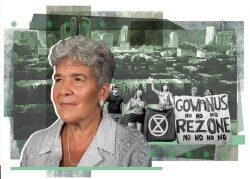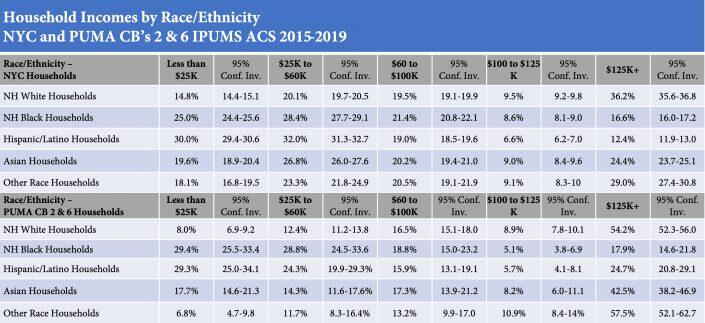The Gowanus rezoning could “meaningfully reduce segregation,” according to a new report.
A racial equity report concludes that the proposal represents an “unprecedented” infusion of low-income housing in “a high-cost, high-opportunity neighborhood.” It would change residential patterns “slightly towards more integration” and could counter “exclusionary development trends.”
On the downside, it says more should be done to preserve auto repair and industrial jobs, which are expected to be adversely affected by the rezoning.
In June, the City Council required racial equity reports as part of certain rezonings as of June 2022. But local Council members Brad Lander and Stephen Levin initiated one for Gowanus voluntarily. Community groups had wanted a study done before the rezoning application began its public review in April.
The analysis was conducted by Columbia University Professor Lance Freeman — who for years has studied and written about gentrification — and staff from the City Council’s land use committee. The Fifth Avenue Committee, a community development corporation that Lander ran for a decade and has proposed a 100 percent affordable project that relies on the rezoning, raised funds for the report.
“This is potentially a very important step that can help land use decision making unfold in a more equitable manner,” Freeman said in an interview.
Read more


The report argues that the rezoning poses a low risk of displacement, pointing to the fact that the vast majority of low-income locals live in rent-regulated housing, where paying tenants are guaranteed lease renewals. According to the analysis, 85.6 percent of nonwhite households in Brooklyn Community Districts 2, 6 and 7 either own their homes or live in rent-regulated or subsidized housing.
It also found that the renters moving into affordable housing under the rezoning would be more diverse than the current population of District 6, which includes Gowanus, Park Slope, Carroll Gardens and other largely white neighborhoods.
The report praises the rezoning’s addition of thousands of affordable units. It says the area’s diversity relies on existing housing for low-income residents, and that new affordable housing planned for the neighborhood will only improve upon that.

Source: Commitee on Land Use/City Council
Citing Census data, the report states that Community Districts 6 and 2 have grown “steadily wealthier and whiter” over the past 15 years. During that time, median household income of white households jumped about 30 percent, from approximately $115,000 to $150,000, while median income for Black and Latino households rose roughly 25 percent, from about $40,000 to $50,000.
The 82-block rezoning would pave the way for more than 8,500 new apartments, 3,000 of which would be set aside for low- and moderate-income New Yorkers. But funding for two nearby public housing developments remains a question. Lander and Levin are demanding $132 million to upgrade Gowanus Houses and Wyckoff Gardens, while City Hall has pitched a fraction of that sum.
The “racial equity report” required for certain future rezonings must detail the affordability levels of the housing they would bring, a breakdown of households by income and race, and in some cases, two years’ worth of information on displacement trends and economic security of residents. Under the measure, the Department of Housing Preservation and Development and the Department of City Planning have until April 1 to create a database that will be used to generate these reports.
The Gowanus study complies with the spirit of the City Council bill, though the database is not yet available.
The report notes that auto-repair and industrial uses would likely lose 400 jobs under the rezoning. Though proposals are on the table to address this, the report states that “the economic development elements of the rezoning currently fall short.”
“The projected loss of industrial space and jobs therefore presents a challenge to racial equity by reducing a reliable source of middle-wage jobs for communities of color,” the report states.
Even without a broad rezoning, the once bustling industrial area has lost the vast majority of its manufacturing jobs over the past five decades. Lander has argued that the rezoning would achieve an equitable, vibrant mix of residential and industrial use.
The report recommends deeper affordability in the housing created under the rezoning, though flexibility on this front is limited. The proposal calls for 35 percent of new housing units to be set aside for individuals making less than 80 percent of the area median income. The city’s Mandatory Inclusionary Housing program does not require quite as much affordability, so meeting the study’s targets would likely require action by the next mayor, Lander said.
The Council member does, however, support a recommendation by the report to include “adjacent, more diverse community districts,” notably those including Fort Greene, Clinton Hill and Sunset Park, in the housing lotteries that give locals first dibs on half of the affordable units created. Under the usual community preference policy, which has been found to reinforce segregation, only District 6 residents would get preference.
Democratic mayoral nominee Eric Adams has said he hopes to reform the policy.
Lander noted that one of Gowanus’ future affordable housing sites once had a concrete plant, which relocated to Sunset Park. For this and other reasons, he said District 7 should benefit from the Gowanus housing lotteries.
“Sunset Park is bearing the burden that is making it possible to create affordable housing here,” he said. He added that future racial equity studies could help guide how community preference applies.
